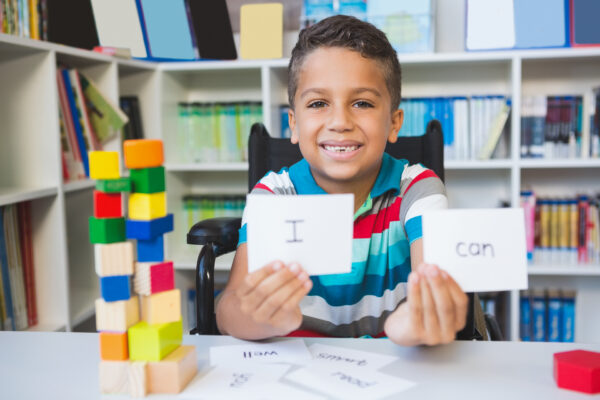Download the Brochure for complete course details
COURSE DESCRIPTION
What does it mean to truly use affirming strategies to connect and communicate with students who use AAC and those who cannot rely on speech alone to be heard and understood? Build your foundation of connection with these students by learning to incorporate all types of AAC in your therapy and educational activities. Communication is not just for speech-language sessions. You can support students’ communication development at the same time as you address motor, regulation, academic and other educational needs. This session is designed to build communication confidence for PTs, OTs and educators, but it is also for the speech pathologist who is just beginning to develop their understanding of this area.
LEARNING OBJECTIVES
- Identify affirming practices to support connection and communication with AAC users and those who cannot rely upon speech alone to be heard and understood.
- Recognize their role in developing the language of emergent AAC users.
- Choose neuroaffirming communication strategies such as honoring echolalia in Gestalt Language Processing.
- Select core vocabulary that can be modeled across a variety of activities during the school day.
AUDIENCE
This course is designed for OTs, PTs, SLPs and Special Educators working with EI, Pediatric and School-Aged Students (K-12) populations.
ON-DEMAND SCHEDULE
I. Five Affirming Practices to Help You Connect and Communicate with AAC Users and Others Who Cannot Rely On Speech Alone
- Honor all forms of communication
- Presume competence
- Respect autonomy
- Nurture positive self-identity
- Promote self-advocacy
II. How any adult working with students can use AAC
- Light Tech, CORE Boards, High Tech, Speech Generating Devices, Apps
III. Language Development & Modeling: Not Just for SLPs
- When and how to use these techniques in play, multisensory experiences, conversation
- How about for students who use presymbolic communication or when symbolic communication is emerging?
- Aided AAC modeling, Aided Language Stimulation Aided Language Input
IV. Putting it all Together into Practice
- Case scenarios
- Learning from mistakes
- Small group discussion and practice in Breakout Rooms
V. Important Ideas and Helpful Tips to Problem Solve and Avoid Communication Breakdowns
- The most powerful words
- For our students who are struggling with regulation
VI. Gestalt Language Processing
- What does modeling look like for Gestalt Language Processing?
- Echolalia and Delayed Echolalia
VII. Affirming Sessions with your PT, OT, SLP and Educator Colleagues
- Case Scenarios and Sample Activities
- Communication Bill of Rights
POST-TEST
Mia Baugher has been a SLP for 33 years. For 17 years, she’s worked at the Community School of Davidson, a K-12 public charter school. Throughout her career, Mia has been motivated and energized by collaborating with those she serves as well as those she works alongside. She has special interests in neurodiversity and supporting those who cannot rely upon speech alone to be heard and understood. She has had the opportunity to present on topics such as neurodiversity and collaboration. She earned both her undergraduate and master’s degrees at Ohio State and spent the first 16 years of her career working with children and adults across a variety of medical settings including acute care, inpatient rehabilitation, and outpatient rehabilitation.
Mia Baugher receives an honorarium from Education Resources. and receives a salary from Community School of Davison.
Mia Baugher has no relevant nonfinancial relationships to disclose.
Once you purchase an online course you will have access to the course materials. If you have purchased this course, please ensure you have logged in to your account in order to take the exam.
Once you purchase an online course, you will have the opportunity to take an exam to test your retention of the material. If you have purchased this course, please ensure you have logged in to your account in order to take the exam. The exam must be completed with a pass rate of 80% or more in order to receive your certificate of attendance.
This course meets the criteria for 2.5 contact hours (0.25 CEUs) Intermediate Level. License #______________. Education Resources Inc. is an AOTA Approved Provider of professional development. Course approval ID#10721. This Distance Learning-Independent course is offered at 2.5 contact hours, 0.25 CEUs. (Intermediate level, OT Service Delivery & Professional Issues). AOTA does not endorse specific course content, products or clinical procedures. This course can be used toward your NBCOT renewal requirements for 2.5 units. Approved Provider for the FL Occupational Therapy Association CE Broker for 3 CE Hours - CE Broker #20-1284070. This course has been approved by the MD State Board of Physical Therapy Examiners for __ Continuing Education Hours. Approval #_____ by the NJ State Board of Physical Therapy Examiners for _____ CEC's. Approved sponsor by the State of IL Department of Financial and Professional Regulation for Physical Therapy for 3 contact hours. Approved provider by the NY State Board of Physical Therapy for 3 contact hours (0.3 CEUs). Education Resources, Inc. is an approved provider for Physical Therapy CEUs in the following states: CA, OK and TX. The following state boards of physical therapy accept other states’ approval: AK, AR, AZ, DC, DE, GA, HI, ID, IN, KS, KY, MA, MI, MO, MS, NC, OR, PA, RI, SC, UT, VA, VT, WI, WY. The following state boards of physical therapy either do not require course pre-approval or do not require CEUs for re-licensure: AL, CO, CT, IA, ME, MT, NE, ND, NH, SD, WA. 2.5 hours of this course qualify towards the discipline-specific hours for the 20-hour requirement for NDTA re-certification. They do NOT qualify towards the 8-hour NDTA Instructor requirement for re-certification.
Education Resources Inc. 266 Main St, Suite 12, Medfield, MA 02052 • 800-487-6530





